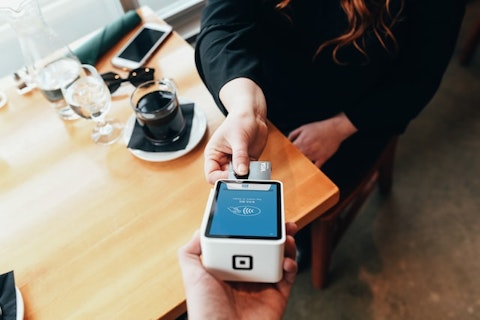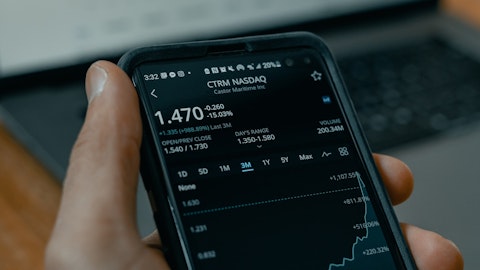Payoneer Global Inc. (NASDAQ:PAYO) Q4 2022 Earnings Call Transcript February 28, 2023
Operator: Good afternoon. Thank you for standing by. Welcome to Payoneer’s Fourth Quarter and Full Year 2022 Earnings Conference Call. At this time, all lines have been placed on mute to prevent any background noise. Following the speakers’ remarks, we will open the line for your questions. As a reminder, this conference call is being recorded. I would now like to turn the call over to Michelle Wang, Payoneer’s VP of Investor Relations. Please, go ahead.
Michelle Wang: Thank you, operator. With me on today’s call are Payoneer’s Co-Chief Executive Officers, John Caplan and Scott Galit; as well as Michael Levine, Payoneer’s Chief Financial Officer; and Bea Ordonez, Payoneer’s Deputy Chief Financial Officer. Before we begin, I’d like to remind you that today’s call may contain forward-looking statements. These forward-looking statements are subject to numerous risks and uncertainties, including those set forth in our filings with the SEC, which are available in the Investor Relations section of our website. Actual results may differ materially from any forward-looking statements we make today. These forward-looking statements speak only as of today and the company does not assume any obligation or intent to update them, except as required by law.
In addition, today’s call may contain non-GAAP measures. These measures should be considered as a supplement to and not as a substitute for GAAP financial measures. Reconciliation to the nearest GAAP measure can be found in today’s earnings release, which is available on the company’s website. With that, I’d like to turn the call over to Scott to begin.
Scott Galit: Thank you to everyone for joining us today to discuss Payoneer’s fourth quarter and full year 2022 earnings. I’ll be discussing our 2022 results and CEO transition, which was announced earlier today. John will cover Payoneer strategy for 2023 and beyond. Michael will discuss our 2022 financial results; and Bea will talk about our 2023 guidance. Payoneer delivered record 2022 results, including revenue of $628 million, representing 33% year-over-year growth and adjusted EBITDA of $48 million, representing 72% year-over-year growth. We are capturing opportunity in a growing $5 trillion addressable market, because of our strategy to build a diversified business and to innovate to help SMBs compete globally. Our relative resilience in the challenging macroeconomic environment highlights the power of our network, the diversity of our business, the value we bring to our customers, their trust in Payoneer and the capabilities of our team.
Payoneer’s 2022 revenue growth reflected continued customer acquisition, adoption of high-value services and the full year benefit of onboarding eBay in 2021. We also increased monetization of customer funds on the Payoneer platform, which is a core part of our business model and will continue to be so going forward. This was partially offset by moderate year-over-year volume declines at some of our e-commerce marketplaces. We have increased our geographic diversity, growing the share of our revenue from Latin America, APAC and SAMENA to nearly 35% of our overall revenues in 2022 and up from approximately 20% four years ago. These faster-growing regions also have higher average take rates. And we are focused on building and growing high-value services, including B2B AP/AR, Commercial Mastercard, working capital and checkout, and we expect these will continue to drive growth in the future.
We grew B2B AP/AR volumes by 39% year-over-year in 2022, and it now represents 12% of our total volumes, up from 9% in 2021. We drove a threefold increase in spend on our virtual Commercial Mastercard year-over-year and exited 2022 with a run rate of over $1 billion. This is an example of how we are innovating to offer more ways for our customers to use their Payoneer account. We also remain optimistic about the long-term growth potential for our working capital and checkout businesses. In working capital, we intend to continue to grow, albeit with an adjusted risk appetite given the current environment. Long term, we believe there is meaningful opportunity to provide emerging market SMEs with access to the capital they need to grow. In our Checkout business, we are seeing positive initial adoption and growth rates following our launch nine months ago.
We have already announced partnerships with platforms including Shopify, Shoplazza and WooCommerce. 2022 volumes of $61 billion were up 8% year-over-year and benefited also from a recovery in travel. Our long-term strategy to diversify geographically and grow high-value services and also increased monetization of customer balances enabled us to deliver 18 basis points of take rate expansion year-over-year. A year ago, we reported our earnings just as the war in Ukraine was beginning. Ukraine is an important market for Payoneer, and we remain committed to supporting our extraordinary Ukrainian customers and employees. Additionally, we work with our partners throughout 2022 to wind down our business in Russia. And as of December 31, 2022, we no longer send payments into Russia.
2022 was an incredibly strong year for Payoneer as we continued our track record of delivering consistent revenue and adjusted EBITDA growth. We have a strong foundation for our next leg of growth, and I am incredibly excited about Payoneer’s future. On February 27, the Board appointed John as CEO effective March 1, and while I will transition to the role of Senior Advisor and continue to serve as a Board member. I’m looking forward to staying actively involved with Payoneer and plan to focus more of my time on strategic projects. As this is my last earnings call, I’d like to say thank you to all of our employees, our customers and our shareholders for their support over the past 12 years. When we first announced John was joining Payoneer, we said that we’d look for John to transition to CEO by the end of 2023 to ensure we didn’t rush the transition.
The transition has progressed very smoothly. And after working closely together over the past nine months, the Board, John and I all felt now was the right time to move forward. I’m enthusiastic about the opportunities Payoneer has, and I have full confidence that John and the strong team that we have will deliver value for our customers, employees and shareholders for many years to come. I’ll now hand it to John to discuss our 2023 strategy.
John Caplan: Thanks, Scott, for your guidance and friendship as we work through the transition. I’m incredibly excited about Payoneer strong position to capture a greater share of a growing market globally and recognize our long-term potential. I’m looking forward to leading Payoneer for its next leg of growth from over $600 million of revenue to multibillions in the years ahead. SMBs that transact globally have cross-border operations, expenses and currencies to manage. They need a holistic and cost-effective solution for managing their global financial operations and accessing the capital they need to grow their business, yet they are underserved by the traditional banking and financial system. In fact, approximately 90% of B2B payment volume relies on legacy payment methods.
Payoneer provides these SMBs with the tools and services they need to grow their businesses. We plan to generate strong long-term revenue growth while driving greater operational efficiency. In 2023, Payoneer expects to more than double adjusted EBITDA, while investing in future growth and profitability. I will now discuss our three core priorities going forward: number one, delivering continued revenue growth; number two, focusing our acquisition and service model on profitable customers; and number three, building our next-generation technology platform. We remain committed to delivering long-term 20%-plus revenue growth. We have created a network and infrastructure with scale and reach and benefit from a trusted brand that drives millions of customer registrations annually.
We will leverage our strength and focus our customer acquisition on higher take rate regions and on growing and scaling high-value services. Payoneer is delivering a global financial operating solution for SMBs. Our core products, accounts receivable, accounts payable and operating account capabilities are at different stages of their maturity and development. We intend to deliver a comprehensive product set that can increase our wallet share and drive greater monetization of existing customer relationships. Our B2B AP/AR business, for example, provides our customers with invoicing, billing and payment tools to make and receive payments from their trade partners around the globe. Approximately one-third of our B2B customers are existing customers, where we were able to increase our value proposition.
The remaining two-thirds are net new to Payoneer, and represent a significant expansion of our addressable market opportunity. B2B customers tend to have more complex needs, including spend management and operating account functionality, which increased their monetization potential over time. This underscores the big opportunity in front of us, and we expect B2B AP/AR to continue to grow faster than our business overall. We plan to also continue diversifying our revenue mix geographically. We remain focused on acquiring more customers in faster-growing, higher take rate regions such as Latin America, EMEA and APAC. To accelerate our revenue growth and our ability to up-sell and cross-sell, we are also evaluating inorganic opportunities. We believe M&A will play a meaningful role in our product road map and help us scale revenue growth.
Our ability to attract a large number of diverse SMBs to our network is a core strength of our business. We are deepening our understanding of our customers’ differences by size, geography, industry and product utilization to better inform and focus our growth strategy, different portfolios of our customers have different profitability profiles. Going forward, we will focus a greater proportion of our go-to-market on adding and retaining profitable active customers. At the same time, we will invest in our platform and product capabilities so that over time, we can profitably serve an even greater number of our customers and the prospects that come to Payoneer every day. Today, approximately a quarter of our active customers drive the majority of our volume, revenue and profitability.
On average, they tend to have the highest retention rates, growth potential and most attractive unit economics. Within this segment are tens of thousands of customers, who do more than $100,000 of volume annually. And we are focusing our go-to-market strategy and partnership efforts on acquiring local life of these larger SMBs. We recently made changes to our go-to-market organization and leadership to fully align and accelerate our efforts. The balance of our customers, those who make it a small portion of our volume and revenue, carry a significant cost to onboard and serve in today’s operating environment. In aggregate, this group of customers resulted in approximately $25 million of operating losses in 2022. Additionally, we have seen a significant growth in the number of applications we receive every month.

Photo by Blake Wisz on Unsplash
Our powerful brand attracts hundreds of thousands of customers every month. On average, we received nearly 400,000 prospect registrations a month in 2022, up 25% versus a year ago. This is a core strength of our business and highlights the significant market demand for a Payoneer account. At the same time, however, we spent over $50 million in 2022 on processing applications that did not become active customers. This represents a meaningful opportunity, and we intend to continue leveraging our brand to cost effectively acquire more SMBs, while significantly reducing the cost to onboard and serve the smaller customers. In the near term, we have begun to address some of this drag on our earnings by implementing a set of focused efforts, including experimenting with new fees and pricing models.
Payoneer has built a strong and trusted brand. And in many markets, we are the on-ramp to the global economy for SMBs. The long-term mission for Payoneer is to profitably serve more of these SMBs, and we are making meaningful investments in our technology platform to do so. In 2023, we plan to invest approximately $30 million to build the next generation of our technology platform. We expect this investment will unlock significant value over time through greater automation, and operating efficiency and faster product delivery, which will better enable our cross-selling and upselling. It will also strengthen our platform, so that we can meet the increasingly complex needs of our customers and global partners, particularly as compliance costs associated with operating a global financial services business continue to rise across the global financial ecosystem.
Building the next generation of our platform will be a multiyear journey, and the first phase in 2023 will focus on our customer onboarding infrastructure. This includes enhancing our AI and predictive tools to better identify and reduce, in fact, the number of prospects applying that are unlikely to ever achieve our target unit economics and our profitability thresholds. We expect to begin seeing the benefits of our investments towards the end of 2023, as we begin transitioning to our new platform. At this time, we expect that half of our investment in 2023 will be expensed, which is reflected in our guidance, which we will discuss in more detail shortly, while the remainder will be capitalized. We plan to also spend an incremental $20 million in our compliance function in 2023 to support ongoing growth of our high-value services and the increasing regulatory complexity of our industry.
We will invest in infrastructure, personnel and plan to add to our global licenses framework to support our future growth. This is required to facilitate the current business we operate, but it importantly also serves as a significant competitive moat. It is increasingly challenging and expensive for any competitor, fintech or traditional bank to build the infrastructure necessary to operate across the breadth of markets and industries in which we serve customers. We recognize the opportunity we have at Payoneer is extraordinary. For our customers, we will continue to innovate and to evolve our offerings, so we can deliver a comprehensive suite of financial services to SMBs with global needs. For our communities, I’m proud to announce that at the end of 2022, we established the Payoneer Foundation for all of our charitable efforts.
We plan to support organizations that are deeply aligned with Payoneer’s values, including small business development and supporting global entrepreneurship. For our employees, we are dedicated to recruiting and retaining the best individuals and ensuring Payoneer remains a great place to work. Our 2022 results and our forward momentum are a direct result of our experienced leaders and talented employees around the world who are passionate and focused on our mission and for our shareholders, we are committed to delivering sustained long-term profitable growth. Before I hand it over to Michael and Bea to discuss fourth quarter financial results and forward guidance in more detail, I’d like to announce that our Board of Directors have appointed Bea as our CFO effective March 1.
I want to thank Michael for his leadership and friendship over the past 11 years. With that, over to you, Michael.
Michael Levine: Thank you, John, and thank you to everyone for joining us. Payoneer delivered another strong quarter and exceeded our guidance for full year revenue, transaction costs as a percentage of revenue and adjusted EBITDA. We saw a 30% or greater year-over-year revenue growth in each quarter of 2022. Q4 revenue increased 32% year-over-year to $184 million, driven by growth of high-value services, continued customer acquisition across diverse geographies and accelerating interest income from growing customer funds and rising interest rates. Sequentially, revenue increased 16%, which also benefited from our typical Q4 seasonality. Q4 volume increased 5% year-over-year and 12% sequentially to $16.9 billion. Volume growth year-over-year was driven by a recovery in travel and continued growth of B2B AP/AR, while e-commerce volumes were slightly lower compared to Q4 of 2021.
B2B AP/AR volume growth for Q4 was 10% year-over-year as we saw the full quarter impact of customer terminations we made in the third quarter. Q4 take rate was 109 basis points, up compared to 86 basis points in the fourth quarter of last year and 105 basis points in Q3. Sequentially, the take rate expansion was driven by higher interest income, partially offset by holiday seasonality, which drives mix shift into large e-commerce customers with lower take rates. Customer funds held by Payoneer have increased nearly $800 million sequentially and over $1.4 billion year-over-year to $5.8 billion. Customers value the ability to get paid, manage their multicurrency funds and make payments around the world. Note, some of this fourth quarter growth is also seasonal.
We have been driving greater monetization from customer fund balances by leveraging our scale to get better economics and a greater share of each subsequent interest rate increase. Further, by working with regulators to secure the appropriate approvals, we were able to optimize our allocation of customer funds to interest-bearing accounts. Now over 80% of customer funds are earning interest versus over 50% a year ago. We earned $36 million of interest income from customer balances in the fourth quarter up from less than $1 million in the prior year period. Sequentially, interest income increased $21 million. Q4 transaction costs were $30 million. This represented 16.6% of revenue an improvement from 20.2% in the fourth quarter of last year and 17.6% versus Q3.
Transaction costs grew at a lower rate than revenue, primarily due to higher interest income revenue. Bank and processor fees, the largest component of transaction costs increased 8% year-over-year, driven by higher volume as well as strong growth in B2B AP/AR, which has relatively higher transaction costs. Q4 revenue less transaction costs increased 38% year-over-year to $153 million representing 83.4% of revenue. Q4 total operating expenses, including transaction costs, were $192 million, up 34% year-over-year, excluding transaction costs, operating expenses of $162 million increased 40% year-over-year and 19% sequentially. On our third quarter earnings call, we noted we were going to make $16 million of discretionary investments in the fourth quarter.
We expect $4 million of these expenses to continue for the full year 2023 and mostly linked to ongoing third-party consulting services. Q4 sales and marketing costs increased $18 million year-over-year, including $8 million of discretionary expenses. The increase in our sales and marketing costs represented approximately 40% of the total year-over-year increase in Q4 operating expenses, excluding transaction costs. It was driven by higher labor expenses, primarily linked to strategic growth hiring in China and Latin America and to support our B2B AP/AR business. As we mentioned on our third quarter call, we invested $8 million in targeted marketing campaigns in Brazil, India, UAE and the Philippines. We saw positive results from our marketing campaigns in terms of awareness, consideration and positive impact of Payoneer brand image.
Given our focus on operating efficiency, we do not plan to continue to spend in 2023, but we’ll use the data from this campaign to inform our future sales and marketing strategies. Q4 R&D expenses increased 29% or $7 million year-over-year, mostly from higher labor expenses as we continue to invest in our platform capabilities. We expect to continue investing in R&D as we enhance our technology platform, which we will discuss in more detail shortly. Other operating expenses increased $10 million in Q4 2022 versus the prior year period, primarily reflecting higher employee and contractor expenses to support ongoing growth of the business. G&A also increased $10 million year-over-year and included $8 million of discretionary investment, which was for third-party consultants and travel expenses as well as charitable contributions to organizations supporting relief efforts in Ukraine.
Additionally, G&A expenses included $2.5 million to launch the Payoneer Foundation, which was not included in our original discretionary investment outlook. Our Q4 adjusted EBITDA was $11 million compared to $14 million in the fourth quarter of last year and $13 million in the third quarter. Q4 net loss was $10 million compared to net loss of $19 million in the fourth quarter of last year. Net loss for Q4 2022 included a $5 million gain from the change in fair value of warrants. Q4 basic and diluted net loss per share was negative $0.03. We continue to generate positive cash flow, and we ended the quarter with cash and cash equivalents of $543 million, a sequential increase of $35 million. As this is my last earnings call, I would also like to say thank you to all our shareholders for their continued interest and support of Payoneer.
Payoneer has delivered strong results and consistently exceeded our revenue and adjusted EBITDA guidance over the past seven quarters since going public in June of 2021, and I remain confident in our ability to execute on our plan. Bea Ordonez, who I have had the pleasure working with over the past few weeks will become CFO as of March 1, and I have the utmost confidence in John and Bea to lead Payoneer into its next phase of growth. I’d like to now turn it over to Bea to discuss 2023 guidance.
Bea Ordonez: Thank you, Michael, for your support during this transition process. I look forward to meeting many of you in the coming weeks and to working together in the years ahead. We see significant opportunities in our business, both near term and long term, to continue to drive revenue growth through prudent investments in our client acquisition efforts, and in our high-value service offerings, while also focusing on driving long-term operating leverage growth through investment in our platform capabilities and infrastructure. In the near-term, 2023 adjusted EBITDA performance is expected to benefit from strong revenue growth, including from interest income and expense rationalization measures, which drive more measured operating expense growth.
In short, we are positioned to deliver meaningful adjusted EBITDA growth in 2023, while also investing to further strengthen and grow our business for the years ahead. For full year 2023, we expect revenues to be between $800 million and $810 million, transaction costs as a percentage of revenue to be approximately 16% and adjusted EBITDA to be between $120 million and $130 million. The midpoint of our latest guidance represents a 28% increase to revenue and a doubling of adjusted EBITDA margins year-over-year. We expect revenue growth to be driven by continued customer acquisition in particular, growth in larger, more profitable customers and in higher take rate regions. We also expect continued growth in our B2B business and other high-value services, and from interest and on our customer balances.
This will be partially offset by approximately $22 million of known headwinds we faced in 2023 from the decline in revenues we earn for certain onboarding services, for an enterprise client and from the full year impact of the closure of payments into Russia at the end of 2022. We expect interest income to be approximately $180 million for 2023, based on our fourth quarter customer funds exit balances, moderate balanced growth in line with volumes, and current anticipated Fed funds interest rate changes. Our ability to monetize customer balances is a core part of our business model. As we have grown volume on our platform, we have seen customer balances grow and have leveraged our scale to drive a greater share of the economics. We expect transaction costs for 2023 to be approximately 16% of revenue.
Transaction costs as a percentage of revenue continued to trend downward year-over-year, as we leverage our scale to drive better pricing while also benefiting from higher interest income revenue. We expect these improvements to continue moderating relative to what we saw over the past two years. This is driven by mix shift into B2B, AP/AR and into regions such as Latin America, SAMENA and APAC with higher take rates and also relatively higher transaction costs. Based on our stated guidance, we expect adjusted OpEx less transaction cost to be between $550 million and $560 million for 2023, representing an approximately 18% year-over-year increase at the midpoint. 2023 operating expenses include an incremental $15 million of annual recurring incentive payments related to an enterprise client.
As John discussed, beginning in 2023, we are investing in the next generation of our technology platform. We expect this to be a multi-year journey to enhance and strengthen our platform to better fit the needs of our growing and complex business. In 2023, we anticipate spending approximately $30 million, $15 million of which will be expensed and is included in our adjusted EBITDA guidance, while the remainder will be capitalized. As we make progress on these investments, we expect to deliver increased automation across our business operations, which will drive down our acquisition costs and our ongoing cost to serve. These investments will also accelerate our ability to launch new products and features and to enhance the customer experience, which will, over time, drive increased customer acquisition, retention and monetization.
As we have noted, customer onboarding costs, including compliance costs and our ongoing cost to serve have contributed meaningfully to the growth in our operating expenses. We expect to see some of the benefits from our platform investments in our 2023 exit run rate, while the full capture of these benefits are expected to occur in 2024 and beyond. Payoneer benefits from a strong local brand and network effect that drives significant inbound customer traffic. In line with other regulated financial institutions, the costs associated with onboarding have been growing, and for a significant portion of inbound customer applications, the cost exceeds the potential revenue we can earn based on our existing operating environment. In the long-term, the evolution of our platform capabilities will allow us to profitably serve a greater proportion of our customers.
In the near-term, we will be focused on better managing our acquisition efforts as well as our existing customer relationships through enhancements that will streamline the onboarding process, reducing the associated costs as well as through pricing strategies related to certain cohorts of customers. We are also focused on driving greater efficiency across our business more broadly and are actively evaluating other areas of spending. Our guidance for 2023 adjusted EBITDA is between $120 million and $130 million. This guidance reflects an approximately 2.5-fold increase in adjusted EBITDA and a doubling of adjusted EBITDA margin versus 2022. In conclusion, Payoneer’s 2022 results once again demonstrated our team’s ability to deliver strong financial results.
We have built a diversified, profitable business, and we see positive and exciting trends in a large and growing market for our products. We have confidence in our ability to meet our 2023 financial targets while investing to position Payoneer for many more years of profitable growth. We are now happy to answer any questions you may have. Operator, please open the line.
See also 12 Best Affordable Dividend Stocks to Buy and 11 High Growth International Stocks to Buy.
Q&A Session
Follow Payoneer Global Inc.
Follow Payoneer Global Inc.
Operator: Thank you The first question on the line comes from Will Nance of Goldman Sachs. Please go ahead, Will. Your line is open.
Will Nance: Hey, guys. I appreciate you taking the question. I just wanted to follow up on some of the learnings that you guys have had from the review of the customer base that you guys are talking about. I was wondering if you could maybe double-click a little bit on the customer cohort that you guys have found that you’re not currently serving profitably. Are there any kind of common threads that kind of run through that customer base across either vertical or product? And I guess the size, we almost think that kind of correlates within that cohort? And I guess just going forward, is the goal to continue to service these clients but not acquire clients like that, or is the goal of some of these investments in the platform to enable you guys to kind of serve them profitably on a go-forward basis?
John Caplan: Hey, Will, John here. That’s a great question. There’s a lot of questions in there. So I’m going to try to sort of give you an answer sort of broadly about our customer acquisition, go-to-market strategy and the portfolios. We have been very successful at acquiring our desired customer profile. And what we see in the portfolio of our customers, customers with higher dollar amounts of volume on a monthly basis are quickly the most profitable customers we serve. And our incentive structure and focus for our go-to-market teams is aligned entirely about acquiring those profitable customers. And our business, if you look at our business broadly, we attract hundreds of thousands, I said in my prepared remarks, 400,000 applicants, prospect applicants every month.
And our goal long term is ultimately to serve all of them or as many of them as we possibly can profitably. And they are geographically diverse. So it’s hard to generalize about any specific customer size or industry or geography, given the dynamic nature of our business and how we operate in over 190 countries. But generally, size drives our economics. And what I think is important is that we think that the investments we’re making in our platform and in onboarding will enable us to serve more of the population of our customers long-term. profitably. It will never be, I believe, that 100% would be profitable, just given the power of our brand globally and the number of people we attract. You and I have talked in the past about, how important it is for a platform like ours to attract customers for such a low-cost, right?
One of the core strengths of Payoneer today is that people view Payoneer as an on-ramp, as an entrepreneur to the global economy. And we believe that’s a very powerful strength. We’re tuning the products we offer, the pricing, our service levels and our acquisition efforts so that we can improve the profitability dynamics in the past.





